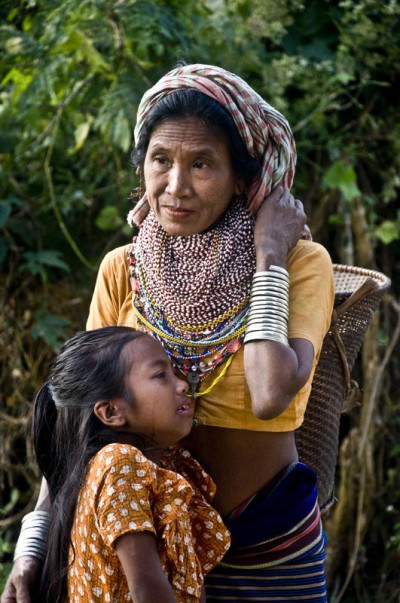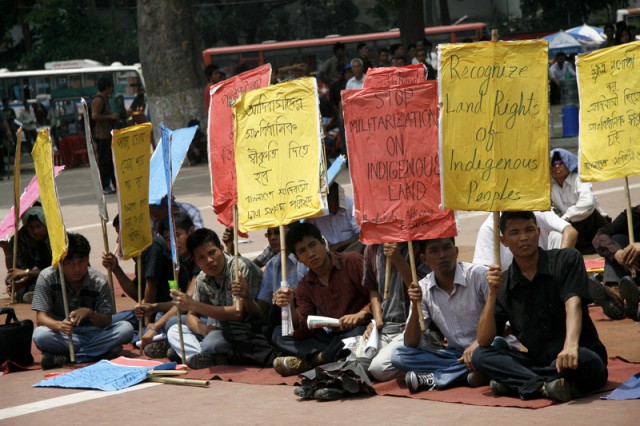This post is part of our special coverage on Indigenous Rights [1].
In Bangladesh there are more than 45 indigenous tribes (adibashis) [2] [bn] of which 11 reside in the Chittagong hill tracts [3]. The rest are scattered in other parts of the country. Many of them are not faring well. Every day some of them are being subjected to discrimination, oppression and abuse.
A report by Kapeng Foundation and Oxfam [4] [bn] entitled “Human Rights Situation of the Adibashis – 2011″, reveals that last year violent racial clashes related to land disputes resulted in the burning down of 111 indigenous homes. Seven tribal people were killed and 12 houses were ransacked. Eleven tribal women were raped in different incidents and five of them were killed.
 [5]
[5]Tribal indigenous people of Bangladesh. Image by Anwar Hussain, copyright Demotix (9 August, 2010).
Mithushilak Murmu [6] [bn] commented on the motivation of these attacks:
It seems that our neighbors, the bigger communities are being mobilized by racial thoughts. The father of the nation Bangabandhu Sheikh Mujibur Rahman's secular thinking and non-racial and inclusive perspectives are being blacked out by his successors. The indigenous people are afraid most of the times, they are living in fear.
Malobika Tudo [7] [bn] said:
The tribal children learn their first words in Bangla, which is not their mother tongue. And it seems there is nobody in this country to speak for them.
Ajal Dewan came to Dhaka from Chittagong Hill Tracts for higher studies. He wrote [8] [bn] in the Adibashi Bangla (Indigenous Bengali) blog how he faced problem with his tribal features:
Most of my experiences in this short lived life are bitter. But the most bitter ones include being bullied for my distinctive face and language. The waiter at the restaurant frowns at me and if I sing a song in my own language in the street I face the same consequence. If I sing or recite in Bangla, there is no problem. [It seems] it's a crime to speak in my language.
There is no respite even in university. My classmates think that we savor snakes and frogs as we live on the hills. I have to answer questions all the time on whether we eat cockroaches or sleep in treehouses. […]
Antoni Rema [9] [bn] has similar experiences:
We are bullied [by men] when we walk down the streets. Especially the fair skinned tribal [women] like us are facing this trouble the most. On the streets, we are being frowned upon with nonsense words (like chang, chung), we are being teased, taunted and distracted. Do they know how much it hurts us?
We can get a feeling about the type of repression the tribal people are subjected to from the posts of Ajal Dewan and Antini Rema. This is not only true for the indigenous people of the hills – all tribes of the country have similar stories to tell.
The oppression on them is motivated by mainly the urge to grab and occupy their lands and livelihoods. Journalist Biplob Rahman wrote in an article [10] [bn] after visiting a tribe in the north of Bangladesh:
In recent times the minority Santal tribes of Birganj, Chirir Bandar, Fulbari and Nababganj of Dinajpur Zila have continued to lost their lands to occupiers. Almost 500000 indigenous Santals have virtually no assets after losing everything over the years.
On the other hand Mithushilak Murmu [11] [bn] writes about the plights of the indigenous labors who work in the tea gardens of Sylhet after visiting them:
They get a wage of Taka 30 (35 US Cents) after a day's hard work. In the early morning they start to pluck tea leaves and fill the bamboo buckets and continue till the evening takes them to the factory. […] The price of tea has increased day by day, but their benefits and wages haven't.
The plights of the discriminated, abused and oppressed tribes were deepened by a remark [12] [bn] by the country's foreign minister. Several months ago in a discussion with the delegates of development organizations and diplomats she mentioned “there is no indigenous people in the country [13]“.
In her opinion, because in the past centuries several tribes have come from neighboring countries to settle in the hills of Bangladesh, they should not be termed as indigenous, but tribal minorities. The indigenous tribes reacted strongly to this statement; they took the streets to protest and claim constitutional recognition.
 [14]
[14]Indigenous people of Bangladesh are demanding constitutional recognition in Dhaka. Image by Abu Ala, copyright Demotix (29/4/2011).
Odong Chakma [15] in a post in Mukto Mona blog depicts how a poster on indigenous people in the Dhaka (Hajrat Shahjalal) International Airport has been altered. A white band has been placed on the caption “smiling indigenous women of Chittagong Hill-Tract” under the picture and it reads now “.. women of Chittagong Hill-Tract”.
The blogger says:
Can you wipe out the indigenous population by wiping the name?
It may be mentioned that although the tribal and Bengali people have lived together for centuries, after the partition of India (in 1947), Muslim settlers came pouring in from India and started to settle in the Chittagong Hill tracts. The confrontations started from there, which became acute when in 1979 the government undertook a program to settle almost half a million people in the indigenous lands.
Ramdaschand Hasda [16] [bn] says in this context:
After living hundreds of years together, the Bengalis and the indigenous people could not be friends.
This post is part of our special coverage on Indigenous Rights [1].